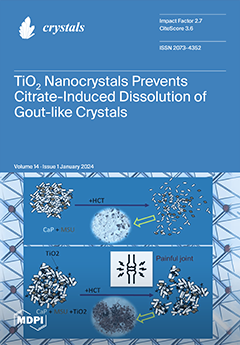Demantoid is the green variety of andradite [Ca
3Fe
2(SiO
4)
3], an exceptionally rare and precious gemstone worldwide. In recent years, a small amount of gem-quality demantoid has been found in Pakistan. This research focuses on nine demantoids sourced from Muslim Bagh, Baluchistan, Pakistan, presenting a comprehensive analysis of the spectral characteristics and inclusions of Pakistani demantoid using classical gemological methods, energy dispersive X-ray fluorescence (EDXRF) chemical analyses, Fourier transform infrared (FTIR) spectroscopy, Raman spectroscopy, and ultraviolet and visible (UV-vis) spectroscopy. The results show that the content of Cr and V in most samples is lower than the detection line of EDXRF, with only one sample containing a Cr
2O
3 content of 0.032%. The extremely low Cr content sets Pakistani demantoid apart from demantoid of the serpentinite type found in other regions. Notably, the UV-vis spectrum reveals characteristic absorption at 443 nm due to Fe
3+, while a further contribution from Cr
3+ would be highly likely, and weak absorption at 550 nm caused by Fe
3+. This suggests that iron (Fe) is the primary chromogenic element of Pakistani demantoid, but the role of Cr
3+ cannot be ignored. The FTIR spectrum of Pakistani demantoid displays the absorption peaks associated with [SiO
4]
4− groups at 937 cm
−1, 848 cm
−1, and 817 cm
−1, while the absorption peaks resulting from trivalent cations appear at 481 cm
−1 and 442 cm
−1, which are the characteristic FTIR spectra of demantoid. Raman spectroscopy further reveals absorption peaks are displayed near 994 cm
−1, 843 cm
−1, 818 cm
−1, associated with (Si–O)
Str vibrations (Si–O stretching vibration), and absorption peaks are displayed near 350 cm
−1 and 310 cm
−1, related to the rotation of SiO
4–R(SiO
4)
4−, and the peaks near 514 cm
−1 and 494 cm
−1 are related to (Si–O)
bend vibrations (Si–O bending vibration). Additionally, related absorption peaks near 168 cm
−1 are attributed to the translation of SiO
4–T(SiO
4)
4−, and absorption peaks near 234 cm
−1 are associated with the translation of X
2+–T(X
2+) (X
2+ represents divalent ions). The common dark opaque inclusions found in Pakistani demantoid consist of a combination of magnetite and hematite. Additionally, some samples of Pakistani demantoid display inclusions of calcite. This unique combination of inclusions differentiates Pakistani demantoid from demantoids sourced from other regions. It signifies that Pakistani demantoid has a distinctive geological origin resulting from the interplay of serpentinization and skarnization processes. This geological formation distinguishes it from demantoids solely hosted in serpentinite or skarn environments in other origins. The identification of these characteristics holds significant importance for accurately determining the origin of Pakistani demantoid.
Full article





